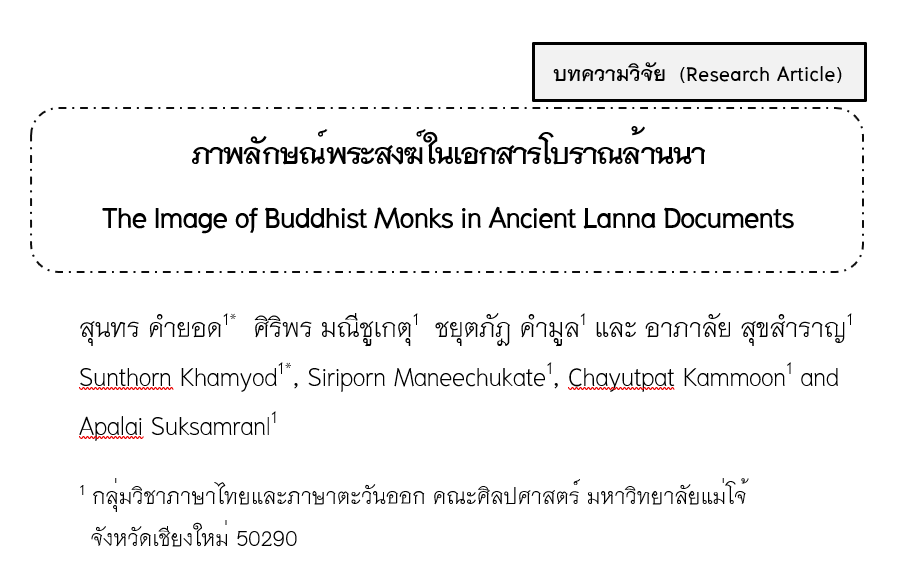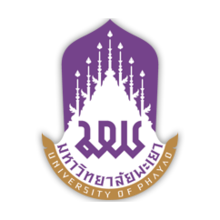The Image of Buddhist Monks in Ancient Lanna Documents
Keywords:
Ideology, Environmental ideology, DiscourseAbstract
This article aims to study the image of Lanna monks from various ancient documents in order to understand the phenomena related to Lanna monks that are based on social structure and the expectations of society on the role of Lanna monks. The results showed that the good image of the monks in the written documents was very rare. While the image of the monks in documents related to the state refers to monks as ordinary people as a part of state and under the authority of the state. For the oral literature will present images of monks who are ordinary people in society, able to make fun of parodies. In addition, it also reflects the Lanna society structure that has the power negotiation in which monks are in the position of food harasser. Therefore, the image of the monks presented is a negative image to release the stress of society. However, the government and the Lanna civil society sectors did not expect the monks in terms of liberation, if only expecting to act in accordance with the principles of morality.
References
คมเนตร เชษฐพัฒนวนิช. (2539). ขึด: ข้อห้ามในล้านนา. เชียงใหม่: สถาบันวิจัยสังคม มหาวิทยาลัยเชียงใหม่.
ชัปนะ ปิ่นเงิน. (2551). การปริวรรตและวิเคราะห์เนื้อหากฎหมายมังรายศาสตร์ฉบับวัดแม่คือ. เชียงใหม่: สถาบันวิจัยสังคม มหาวิทยาลัยเชียงใหม่.
ทรงศักดิ์ ปรางค์วัฒนากุล. (2532). การศึกษาเปรียบเทียบคำอู้บ่าวอู้สาวล้านนาและผญาเกี้ยวอีสาน. เชียงใหม่: คณะมนุษยศาสตร์ มหาวิทยาลัยเชียงใหม่.
ธเนศ วงศ์ยานนาวา. (2529). มิเชล ฟูโกต์: ปัญญาชน ความจริง และอำนาจ. เศรษฐศาสตร์การเมือง, 5(1-2), 142-154.
นิธิ เอียวศรีวงศ์. (2538). ผ้าขาวม้า, ผ้าซิ่น, กางเกงใน และ ฯลฯ: ว่าด้วยประเพณี, ความเปลี่ยนแปลง และเรื่องสรรพสาระ. กรุงเทพฯ: มติชน.
บุญคิด วัชรศาสตร์. (2550). ภาษิตคำเมืองเหนือ. เชียงใหม่: ธาราทองการพิมพ์.
ประเสริฐ ณ นคร. (2546). โคลงนิราศหริภุญชัย ศาสตราจารย์ ดร.ประเสริฐ ณ นคร สอบกับต้นฉบับเชียงใหม่. กรุงเทพฯ: มหาวิทยาลัยศรีนครินทรวิโรฒ.
พระครูบามนตรี ธมฺมเมธี. (2539). ของดีจากพับใบลาน เมืองเหนือล้านนา. เชียงใหม่: สิงห์คำการพิมพ์.
พระครูอดุลสีลกิตติ์. (2562). โอวาทานุสาสนีย์ ฉบับวัดบวกครกหลวง จารเมื่อ พ.ศ. 2400. เชียงใหม่: เอกสารอัดสำเนา.
พรรณเพ็ญ เครือไทย. (2540). เพลงกล่อมเด็กล้านนา. เชียงใหม่: สถาบันวิจัยสังคม มหาวิทยาลัยเชียงใหม่.
พรรณเพ็ญ เครือไทย. (2542). ปริศนาคำทายล้านนา. เชียงใหม่: สถาบันวิจัยสังคม มหาวิทยาลัยเชียงใหม่.
ไพฑูรย์ ดอกบัวแก้ว. (2536). คร่าวดอยสุเทพและคร่าวซอสร้างถนนในเมืองเชียงใหม่. เชียงใหม่: สถาบันวิจัยสังคม มหาวิทยาลัยเชียงใหม่.
สถาบันวิจัยสังคม. (2539). กำบ่าเก่าเล่าไว้ (ภาษิตคนเมือง). เชียงใหม่: สถาบันวิจัยสังคม มหาวิทยาลัยเชียงใหม่.
สมร เจนจิจะ. (2541). ภาษิตล้านนา. เชียงใหม่: สุริวงศ์บุ๊คเซนเตอร์.
สารานุกรมวัฒนธรรมไทย ภาคเหนือ. (2542). สารานุกรมวัฒนธรรมไทย ภาคเหนือ. กรุงเทพฯ: มูลนิธิสารานุกรมวัฒนธรรมไทย ธนาคารไทยพาณิชย์.
สุรเดช โชติอุดมพันธ์. (2559). ทฤษฎีวรรณคดีวิจารณ์ตะวันตกในคริสต์ศตวรรษที่ 20. กรุงเทพฯ: สำนักพิมพ์แห่งจุฬาลงกรณ์มหาวิทยาลัย.
เสนาะ เจริญพร. (2548). ผู้หญิงกับสังคมในวรรณกรรมไทยยุคฟองสบู่. กรุงเทพฯ: มติชน.
หทัยวรรณ ไชยะกุล. (2539). การสร้างมุขตลกในเรื่องขำขันของล้านนา (วิทยานิพนธ์ศิลปศาสตรมหาบัณฑิต). เชียงใหม่: มหาวิทยาลัยเชียงใหม่.
อุดม รุ่งเรืองศรี. (2542). โวหารล้านนา. เชียงใหม่: ภาควิชาภาษาไทย คณะมนุษยศาสตร์ มหาวิทยาลัยเชียงใหม่.
อุดม รุ่งเรืองศรี. (2544). โคลงอมรา. เชียงใหม่: ศูนย์ศึกษาปัญหาเมืองเชียงใหม่.
อุดม รุ่งเรืองศรี. (2552). สำนวนล้านนา. เชียงใหม่: กองทุนศาสตราจารย์อันนิมมานเหมินท์.

Downloads
Published
How to Cite
Issue
Section
License
Copyright (c) 2022 Phayao University

This work is licensed under a Creative Commons Attribution-NonCommercial-NoDerivatives 4.0 International License.
ผู้นิพนธ์ต้องรับผิดชอบข้อความในบทนิพนธ์ของตน มหาวิทยาลัยพะเยาไม่จำเป็นต้องเห็นด้วยกับบทความที่ตีพิมพ์เสมอไป ผู้สนใจสามารถคัดลอก และนำไปใช้ได้ แต่จะต้องขออนุมัติเจ้าของ และได้รับการอนุมัติเป็นลายลักษณ์อักษรก่อน พร้อมกับมีการอ้างอิงและกล่าวคำขอบคุณให้ถูกต้องด้วย
The authors are themselves responsible for their contents. Signed articles may not always reflect the opinion of University of Phayao. The articles can be reproduced and reprinted, provided that permission is given by the authors and acknowledgement must be given.







